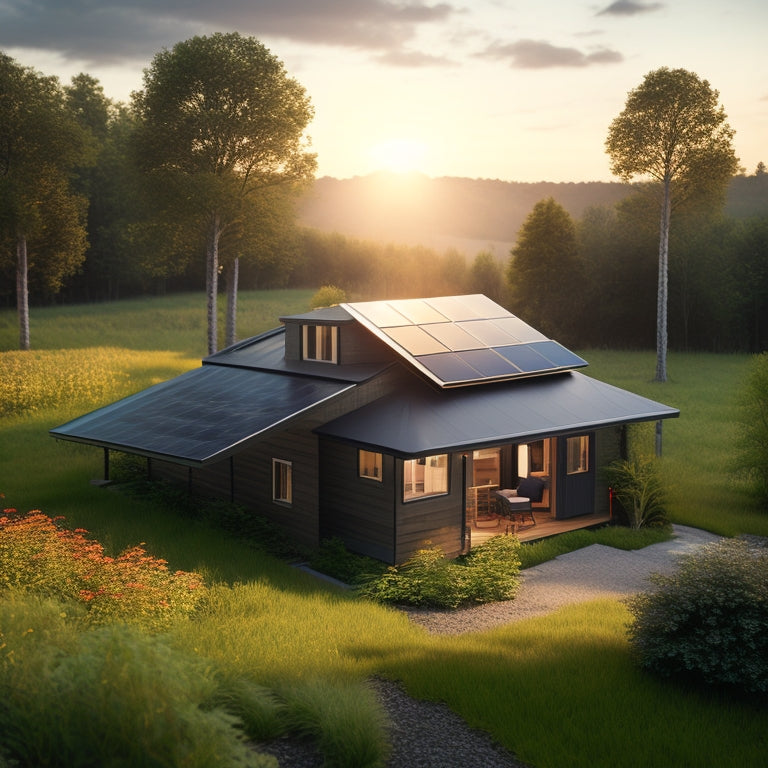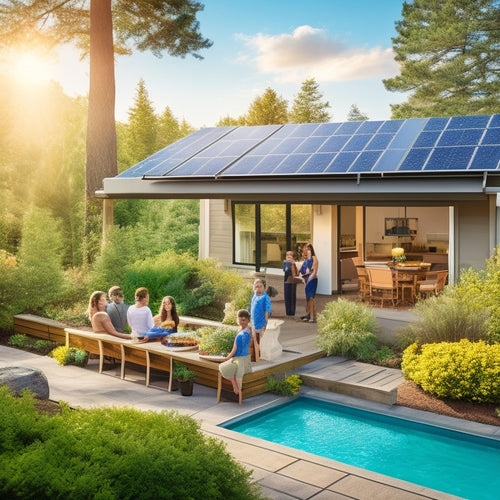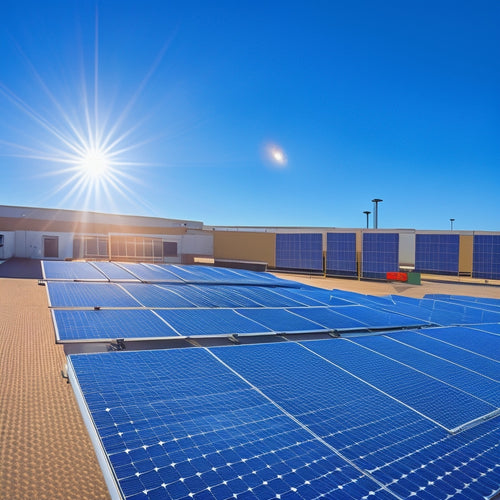
Diy Off Grid Solar
Share
By embracing DIY off-grid solar, you can break free from grid dependence, slashing your energy bills by up to 90% and joining the growing ranks of over 1 million American households already utilizing renewable power. You'll achieve energy independence, reduce your carbon footprint, and maintain energy reliability during grid outages. Evaluating your daily energy usage patterns is essential for sizing your off-grid solar system, and understanding your consumption breakdown will help you design a reliable system customized to your specific energy needs. With the right system design, you can optimize energy collection, maximize energy conversion rates, and now you're ready to take the next step towards taking control of your energy future.
The Essentials
- Achieving energy independence with DIY off-grid solar systems relies on understanding daily energy usage patterns to size the system correctly.
- Shifting to DIY off-grid solar reduces energy costs and reliance on traditional grid-based energy, contributing to a sustainable energy supply.
- Proper installation, cleaning, and maintenance of solar panels ensure optimal energy harvesting, with high-efficiency panels achieving up to 22% efficiency.
- Effective energy storage solutions, such as reliable battery systems, provide consistent power supply and energy storage during grid outages or nighttime use.
- Government incentives, tax credits, and renewable energy grants support the transition to renewable energy, offsetting initial investment costs and promoting a sustainable future.
Zero Reliance on Grid
You're aiming for energy independence now, and a zero-reliance off-grid solar system is the key.
By utilizing renewable power sources, you'll reduce your reliance on the grid to zero, ensuring a consistent and sustainable energy supply.
With an all-encompassing off-grid solar power system, you can break free from the constraints of traditional grid-based energy and enjoy a seamless shift to off-grid energy independence.
This setup will provide you with the freedom to generate your own power, no matter what happens to the grid.
Energy Independence Now
Achieving energy independence now means breaking free from the grid's constraints, relying solely on your off-grid solar system to power your daily needs.
You'll no longer be bound by the grid's limitations, and you'll enjoy the freedom that comes with generating your own clean energy.
With a well-designed off-grid solar system, you'll have the power to choose how you live your life, without relying on external energy sources.
A reliable battery is the backbone of a self-sufficient lifestyle, providing a seamless and dependable power supply that maximizes energy storage and minimizes maintenance Deep Cycle Power Storage.
This is especially important considering the common challenges of inconsistent power supply and premature battery degradation.
With a sturdy solar battery storage system, you can store excess energy generated during the day for use at night or during power outages.
This means you can maintain your off-grid lifestyle, even when the grid is down.
Renewable Power Source
With your off-grid solar system up and running, you're now utilizing the power of renewable energy to fuel your daily life. This means you've successfully shifted from relying on the grid to generating your own clean energy.
By capturing the sun's energy through solar technology, you're reducing your carbon footprint and contributing to a more sustainable future. As you enjoy the benefits of off-grid living, you can also investigate other Alternative Energy Solutions to further minimize your reliance on traditional power sources.
Additionally, you can take advantage of energy storage systems, such as deep cycle batteries, to guarantee a consistent power supply. As a result, you're no longer tied to the grid's fluctuations and outages.
You have complete control over your energy consumption, and you can rest easy that your power source is reliable and consistent. This newfound independence also allows you to adopt sustainable practices that align with your values and goals.
Renewable Energy Savings
When you shift to a DIY off-grid solar system, you'll start reaping the benefits of renewable energy savings.
Not only will you reduce your reliance on non-renewable energy sources, but you'll also increase your energy efficiency and contribute to a more sustainable future.
You'll reduce your energy costs considerably, as you'll no longer be reliant on the grid and its fluctuating prices.
Additionally, you'll be eligible for green power incentives, which can further offset the initial investment in your off-grid solar setup.
Energy Cost Reduction
Your wallet feels the impact of rising energy costs, and reducing them is a top priority. With a DIY off-grid solar system, you're taking a significant step towards energy independence and cost savings. By utilizing the power of the sun, you can drastically reduce your reliance on the grid and lower your energy bills.
To maximize your energy cost reduction, it's vital to evaluate solar financing options that fit your budget. Look for financing plans that offer flexible repayment terms, low interest rates, and minimal upfront costs. This will enable you to start saving money on energy costs from day one.
In addition to solar financing, energy storage solutions play an important role in optimizing your energy cost reduction. By storing excess energy generated during the day for use during the night or on cloudy days, you can guarantee a consistent and reliable power supply.
This not only reduces your energy costs but also increases your energy independence. By combining the right solar financing options with energy storage solutions, you can unleash the full potential of your DIY off-grid solar system and enjoy significant energy cost savings.
Green Power Incentives
The government's pocket is open to support your shift to renewable energy, and you can capitalize on green power incentives to amplify your energy savings.
As you commence your DIY off-grid solar expedition, you'll be pleased to know that various financial incentives are available to offset the initial costs.
You can benefit from solar tax credits, which allow you to claim a considerable portion of your solar panel installation expenses against your taxes. Renewable energy grants and government rebates are also available to help cover the upfront costs.
Additionally, many eco-friendly programs and sustainable energy initiatives offer financial incentives to encourage individuals to adopt green energy solutions.
When it comes to financing your solar project, you'll find a range of options, including green building incentives and specialized solar financing options.
These incentives can greatly reduce the financial burden of going off-grid, making it more accessible and affordable.
Maximum Power Point Tracking
You've got a solar panel system, but are you getting the most out of it?
Maximum Power Point Tracking (MPPT) is essential to guarantee your solar panels operate at their maximum efficiency, as it continuously monitors and adjusts the panel's voltage to optimize energy harvesting.
By implementing MPPT, you can maximize your renewable energy savings and get the most bang for your buck.
With a well-designed off-grid solar systems setup, you can enjoy backup power during outages and reduce your utility bills.
Solar Panel Efficiency
Solar Panel Efficiency
Most commercial solar panels operate at an average efficiency of around 15-20%, which means that up to 80-85% of the sun's energy is lost as heat. This is because the energy absorbed by the photovoltaic cells is converted into electrical energy, while the remaining energy is dissipated as heat.
To enhance your solar panel's efficiency, you need to guarantee ideal operating conditions. You can improve efficiency by keeping your panels clean, as dirt and debris can reduce energy output. Proper panel installation techniques, such as installing panels at the ideal angle and orientation, also play a vital role.
Solar technology advancements have led to the development of high-efficiency panels that can achieve efficiencies of up to 22%. These advanced panels use innovative materials and designs to minimize energy loss and maximize energy output.
Optimal Energy Harvesting
Your DIY off-grid solar system's performance relies heavily on ideal energy harvesting, which is achieved through Maximum Power Point Tracking (MPPT).
MPPT guarantees your system extracts the maximum energy from your solar panels, even under varying environmental conditions. To enhance energy harvesting, consider the solar panel orientation, factoring in the site assessment criteria and local climate impact. This will help you maximize energy production during seasonal energy fluctuations.
When selecting an inverter, refer to the inverter selection guide to verify it's compatible with your battery storage solutions and can handle the system's maximum power output.
Regular off-grid system maintenance is essential to guarantee peak performance. Employ energy monitoring tools to track your system's performance and identify areas for improvement.
Conducting an energy audit process will help you identify energy-intensive appliances and refine your energy usage. By following these tips, you'll be able to leverage the maximum energy from your solar panels, achieving energy independence and freedom from the grid.
Assess Your Energy Demands
You need to understand your daily energy usage patterns to determine the size of your off-grid solar system. Start by tracking your energy consumption breakdown, including the wattage and usage hours of each appliance, to identify areas of high energy demand.
When designing your off-grid solar system, consider integrating eco-friendly roof solar panels with advanced battery solutions renewable energy storage to guarantee a reliable and efficient energy supply.
Daily Energy Usage Patterns
Evaluating daily energy usage patterns is essential to determining the size and type of off-grid solar system required to meet specific energy demands. You need to understand how you use energy throughout the day to design a system that can keep up with your needs. This involves identifying your energy habits, including when you use the most energy and what appliances are consuming the most power.
To get a better understanding of your daily energy usage patterns, take a closer look at your daily routine. When do you wake up and turn on the lights? When do you start cooking breakfast? When do you start using your computer or TV? Tracking your energy usage throughout the day will help you identify patterns and peak usage times.
| Time of Day | Energy Usage |
|---|---|
| 6:00 AM - 8:00 AM | High (lights, coffee maker, toaster) |
| 8:00 AM - 12:00 PM | Medium (computer, refrigerator) |
| 12:00 PM - 4:00 PM | High (oven, air conditioner) |
| 4:00 PM - 10:00 PM | Medium (lights, TV) |
Energy Consumption Breakdown
Typically, off-grid solar systems are designed to meet specific energy demands, which makes it essential to evaluate your energy consumption breakdown. To do this, you'll need to conduct an energy audit, which involves tracking your energy usage patterns over a period of time. This will help you identify areas where you can optimize your consumption habits.
Start by categorizing your energy usage into different loads, such as lighting, refrigeration, and electronics. Then, calculate the total watt-hours (Wh) required to power each load daily. For example, if you have a 10W LED light that runs for 8 hours a day, it'll consume 80Wh (10W x 8h) of energy daily.
Next, calculate the total daily energy consumption by adding up the Wh requirements of all your loads. This will give you a clear illustration of your energy demands, allowing you to size your off-grid solar system accurately.
Be sure to take into account seasonal variations in your energy consumption habits, as this will impact your system's design. By understanding your energy consumption breakdown, you can design an off-grid solar system that meets your specific needs, ensuring you have a reliable source of energy and the freedom you desire.
Higher Energy Conversion Rate
You're now focusing on maximizing your solar panel's energy conversion rate, which directly impacts your overall system's performance.
To achieve a higher energy conversion rate, you need to optimize your system for maximum power output, measured in watts (W).
Maximum Power Output
Efficiency is the name of the game when it comes to utilizing the sun's energy, and maximizing power output is crucial to achieving a higher energy conversion rate.
To get the most out of your DIY off-grid solar system, you'll want to optimize your solar panel placement to capture as much sunlight as possible. This means positioning your panels at the ideal angle and direction to soak up the sun's rays.
Proper solar panel placement can increase your power output by up to 40%. Additionally, investing in high-quality battery storage solutions will help you store excess energy generated during the day for use at night or on cloudy days. This will guarantee a consistent power supply and reduce your reliance on the grid.
When selecting battery storage solutions, consider factors such as depth of discharge, cycle life, and charge/discharge rates to make sure you're getting the most out of your system.
Frequently Asked Questions
Can I Install DIY Off-Grid Solar Panels on a Rented Property?
When considering solar panels on a rented property, you'll face rented limitations, like obtaining landlord approval and maneuvering installation challenges, which might hinder your freedom to utilize renewable energy, making it essential to weigh the pros and cons before investing.
How Do I Maintain My Off-Grid Solar System During Extended Vacations?
While you're sipping margaritas on a beach, your off-grid solar system is still working hard. To guarantee a smooth return, you'll want to prioritize battery maintenance and system monitoring, so your energy independence awaits you, ready to shine.
Are DIY Off-Grid Solar Systems Suitable for Small Homes or Apartments?
When considering small homes or apartments, you'll find that energy-efficient systems can thrive, providing cost savings and independence. DIY off-grid solar systems can be a great fit, offering flexibility and autonomy, especially when designed with energy efficiency in mind.
Can I Use a DIY Off-Grid Solar System to Charge My Electric Vehicle?
Trading gas stations for sunshine, you wonder if your electric vehicle can thrive on solar power alone. Fortunately, a DIY off-grid solar system can charge your EV, but it's essential to evaluate the charging capacity and solar efficiency to guarantee a seamless, freedom-filled ride.
Do DIY Off-Grid Solar Systems Require Special Permits or Licenses?
When installing any alternative energy system, you'll need to maneuver through the permitting process, guaranteeing compliance with legal requirements, which vary by location, so research and understand local regulations to avoid fines and secure your freedom to utilize renewable energy.
Final Thoughts
As you flip the switch on your DIY off-grid solar setup, you're catapulted into a future where energy independence is the new black. You've broken free from the shackles of grid reliance, utilizing the power of renewables to fuel your modern lifestyle. With maximum power point tracking and higher energy conversion rates, you're maximizing your solar harvest. Now, go forth and illuminate your world, off-grid warrior!
Related Posts
-

Why Outdoor Solar Lighting Systems Are Sustainable
Outdoor solar lighting systems are sustainable because they utilize renewable energy, drastically reducing your carbo...
-

Top-Rated Home Solar Power Kits for Achieving Energy Independence
Top-rated home solar power kits enable you to achieve energy independence by greatly cutting your energy costs. You c...
-

Essential Solar Panel Mounts for Commercial Properties
When it comes to essential solar panel mounts for your commercial property, durability and wind resistance are key fa...


